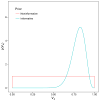Bayesian statistical approaches to evaluating cognitive models
- PMID: 29193776
- PMCID: PMC5814360
- DOI: 10.1002/wcs.1458
Bayesian statistical approaches to evaluating cognitive models
Abstract
Cognitive models aim to explain complex human behavior in terms of hypothesized mechanisms of the mind. These mechanisms can be formalized in terms of mathematical structures containing parameters that are theoretically meaningful. For example, in the case of perceptual decision making, model parameters might correspond to theoretical constructs like response bias, evidence quality, response caution, and the like. Formal cognitive models go beyond verbal models in that cognitive mechanisms are instantiated in terms of mathematics and they go beyond statistical models in that cognitive model parameters are psychologically interpretable. We explore three key elements used to formally evaluate cognitive models: parameter estimation, model prediction, and model selection. We compare and contrast traditional approaches with Bayesian statistical approaches to performing each of these three elements. Traditional approaches rely on an array of seemingly ad hoc techniques, whereas Bayesian statistical approaches rely on a single, principled, internally consistent system. We illustrate the Bayesian statistical approach to evaluating cognitive models using a running example of the Linear Ballistic Accumulator model of decision making (Brown SD, Heathcote A. The simplest complete model of choice response time: linear ballistic accumulation. Cogn Psychol 2008, 57:153-178). WIREs Cogn Sci 2018, 9:e1458. doi: 10.1002/wcs.1458 This article is categorized under: Neuroscience > Computation Psychology > Reasoning and Decision Making Psychology > Theory and Methods.
© 2017 Wiley Periodicals, Inc.
Figures





References
-
- Brown SD, Heathcote A. The simplest complete model of choice response time: Linear ballistic accumulation. Cogn Psychol. 2008;57:153–78. - PubMed
-
- Lewandowsky S, Farrel S. Computational modeling in cognition: Principles and practice. Thousand Oaks, CA: Sage Publications; 2011.
-
- Nosofsky RM. Exemplar-based approach to relating categorization, identification, and recognition. In: Ashby G, editor. Multidimensional Models of Perception and Cognition. Hillsdale, NJ: LE; 1992. pp. 363–94. http://psycnet.apa.org/psycinfo/1992-98026-014.
-
- Richler JJ, Palmeri TJ. Visual category learning. Wiley Interdiscip Rev Cogn Sci. 2014;5:75–94. - PubMed
Publication types
MeSH terms
Grants and funding
LinkOut - more resources
Full Text Sources
Other Literature Sources

